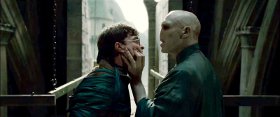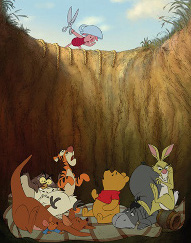 HARRY POTTER & THE DEATHLY HALLOWS: PART 2
HARRY POTTER & THE DEATHLY HALLOWS: PART 2
As the end credits began rolling at my screening of Harry Potter & the Deathly Hallows: Part 2, the (need I say it?) final installment in the film series adapted from J.K. Rowling's beloved novels, I'll admit that I anticipated more applause than I actually heard. Then again, it's awfully hard to clap while simultaneously wiping tears from your cheeks.
Bigger than the surprise of the respectful silence, however, was the shock of my own reaction to the finale, as I was one of those viewers whose weeping at the movie's final image left him in no state to applaud. For nearly 10 years, my interest in this cinematic universe has rarely risen above middling (2004's Harry Potter & the Prisoner of Azkaban is the only entry of the first seven that I legitimately adored), and for all of its technical proficiency and on-screen talent, I found last fall's first half of Deathly Hallows a mostly tough sit. Yet from its first images, I was absolutely knocked out by the epic grandeur and unabashed emotionalism of director David Yates' Harry Potter closer, a culminating adventure so thrillingly wrought and deeply, unexpectedly moving that it left me a little shaken. Shaken, and after roughly a half-dozen miniature crying jags, a little dehydrated.
As I'll mention for the last time until some enterprising Hollywood hacks (inevitably) decide to reboot the franchise, I've yet to read Rowling's literary serial, and as the movie adaptations have always been designed specifically for the books' devoted, there were some elements to this latest, last entry that would no doubt make more sense had I a keener knowledge of Potter lore. Why is it, for instance, that the nefarious Voldemort (Ralph Fiennes) appears psychically linked to Harry (Daniel Radcliffe) and ever-cognizant of his activities, yet has no awareness of his presence when the young man is crouching outside a window 10 feet away from him? How is Voldemort - the most dreaded, most powerful of all über-villains - so easily fooled by a game of possum? (Would it have pained him to check for a pulse or hold a mirror under his victim's mouth?) And if Hogwarts is indeed populated by students practicing the arts of wizardry and witchcraft, why, when their school is under siege, do all but a handful shriek and race about as if looking for the nearest escape hatch? Were none of them given magic wands for their birthdays?
Still, as I'll happily attest, Deathly Hallows: Part 2 is the rare on-screen Potter adventure that requires neither CliffsNotes nor an accompanying Rowling fan for you to be wholly, rapturously taken with its delicate interweaving of mournful sadness and unbridled exhilaration. (It should go without saying that frequent sparks of wit are also on display, beginning with a honey of a funny/nervy scene in which Helena Bonham Carter acts the role of Emma Watson's Hermione acting the role of Carter's Bellatrix LeStrange.) With the visuals having steadily - and, over the last few releases, vastly - improved from movie to movie, there are breathtaking images galore, among them a vault where metallic objects multiply like shiny Tribbles when touched, and a stunning pair of dragons, one of them fire-breathing, and one literally made of fire. Yet what you might find yourself responding to most is the wrenching finality of Yates' offering. The crumbling edifices and Dementor attacks and gargantuan tarantulas are amazing, but it might not take more than a late-film reunion with Michael Gambon's deceased Dumbledore - or a quick flashback to the cherubic faces of Harry, Hermione, and Ron (Rupert Grint) in Harry Potter & the Sorcerer's Stone - to turn you into a blubbery wreck.
Because even if, like me, you haven't been in thrall to the Harry Potter movies, it's borderline-impossible not to be awed the singular achievement of this series, and Yates' final endeavor in particular. Seriously, how did filmmakers and audiences get this lucky? How is it that Radcliffe, Watson, and Grint blossomed so fully from adorable (if mannered) tykes into such committed, nuanced actors? How did so many ridiculously gifted performers not only sign up for roles, but continue, in film after film, to explore them with a depth of feeling that even Rowling couldn't have anticipated? (Oscar nominations here for Fiennes and Alan Rickman - Severus Snape, now and forever - wouldn't be at all unearned.) How have the human and supernatural elements been so carefully balanced that an impromptu, impassioned kiss carries as much dramatic weight as an effects-heavy battle royale? And how did it take 77 years for Maggie Smith to finally emerge as a butt-kicking action star? Harry Potter & the Deathly Hallows: Part 2 is the end of a rather remarkable saga in the realm of Hollywood-blockbuster movie-making. I couldn't be more grateful to David Yates and company for ensuring that it's also a remarkable movie.
 WINNIE THE POOH
WINNIE THE POOH
Running just over an hour, directors Stephen J. Anderson's and Don Hall's Winnie the Pooh - which follows the Hundred Acre Wood gang as they attempt to find Eeyore's tail and save Christopher Robin from a mysterious (and imaginary) creature called the Backson - is nothing if not slight. For what it is, it's also just about freakin' flawless. At best, I was hoping that Disney's hand-drawn animated tale would be charming in a nostalgic, pre-3D kind of way. But what I absolutely didn't expect was that the film would be as fantastically funny as it is, with Pooh's vocals (supplied by the pitch-perfect Jim Cummings) a source of constant delight, a number of slapstick scenarios terrifically smart, and the ongoing tête-à-tête between Pooh and narrator John Cleese reminiscent of Daffy Duck's frenzied battle with his animator in the surreal Looney Toons classic "Duck Amuck." (Rousting Pooh from his slumber, our storybook guide slides the silly ol' bear out of bed by turning the book sideways.) If you have young kids, I'm not sure there's much need to see the movie at the cineplex, because once your children end up owning the movie, you're probably going to find yourselves watching it - or hearing it from another room - hundreds of times over. Winnie the Pooh, though, is so breezy and clever and laugh-out-loud funny that you might not even mind the eventual repetition, nor the sprightly songs that your young uns will no doubt be singing ad nauseam. For a minor release, it's major fun, and is even preceded by a delightful animated short titled The Ballad of Nessie, a Loch Ness Monster fable that teaches kids that, sometimes, it's all right to cry. Wish I had seen that before embarrassing myself at the latest Harry Potter. Oh, bother.










